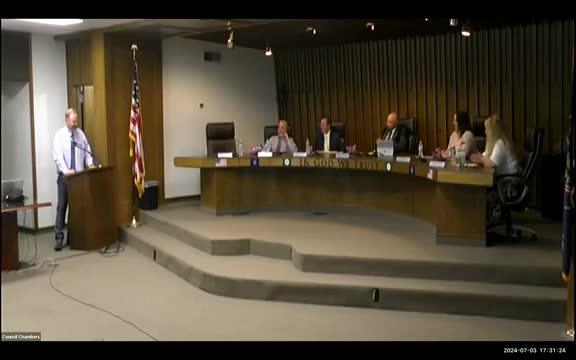Solar Policy Sparks Debate Over Power Pricing Strategies
July 08, 2024 | Payson City Council , Payson, Utah County, Utah

This article was created by AI summarizing key points discussed. AI makes mistakes, so for full details and context, please refer to the video of the full meeting. Please report any errors so we can fix them. Report an error »

In a recent government meeting, officials from Basin City discussed the growing impact of solar energy on the local power market and proposed adjustments to the city's distributed generation program. Dave Vasquez, an employee at the local power plant, presented findings from his six-month study on solar policy and its implications for the community.
Vasquez highlighted the rapid increase in solar installations in the area, noting that permits for new solar projects are being submitted weekly. He explained that solar energy production peaks between 10 AM and 2 PM, a time when residential power demand is typically low. This mismatch has led to significant fluctuations in power prices, with some instances of negative pricing observed this spring, meaning the city was effectively paid to take energy from solar customers.
The presentation also drew comparisons to California's solar market, which has experienced similar trends, including the emergence of the \"duck curve\" phenomenon, where solar energy production leads to a drastic drop in demand during midday hours. Vasquez noted that while Basin City has not yet seen the full effects of solar on its load profile, shifts in peak demand times are already evident, with peaks moving later into the evening.
To address the financial implications of these changes, the city is conducting a rate study to propose new rates and impact fees. Vasquez suggested that the current buyback rate for residential solar customers, which varies based on installation date, should be adjusted to align more closely with market rates, potentially lowering it to around 3 to 4 cents per kilowatt-hour.
Additionally, officials discussed the need to revise the monthly service charge for all customers to better reflect the fixed costs of maintaining the utility infrastructure. The proposed increase aims to alleviate the financial burden on non-solar customers who are currently subsidizing the infrastructure costs for solar users.
The meeting concluded with a call for community input on the proposed changes, emphasizing the importance of ensuring fairness in the utility's pricing structure as solar energy continues to grow in popularity.
Vasquez highlighted the rapid increase in solar installations in the area, noting that permits for new solar projects are being submitted weekly. He explained that solar energy production peaks between 10 AM and 2 PM, a time when residential power demand is typically low. This mismatch has led to significant fluctuations in power prices, with some instances of negative pricing observed this spring, meaning the city was effectively paid to take energy from solar customers.
The presentation also drew comparisons to California's solar market, which has experienced similar trends, including the emergence of the \"duck curve\" phenomenon, where solar energy production leads to a drastic drop in demand during midday hours. Vasquez noted that while Basin City has not yet seen the full effects of solar on its load profile, shifts in peak demand times are already evident, with peaks moving later into the evening.
To address the financial implications of these changes, the city is conducting a rate study to propose new rates and impact fees. Vasquez suggested that the current buyback rate for residential solar customers, which varies based on installation date, should be adjusted to align more closely with market rates, potentially lowering it to around 3 to 4 cents per kilowatt-hour.
Additionally, officials discussed the need to revise the monthly service charge for all customers to better reflect the fixed costs of maintaining the utility infrastructure. The proposed increase aims to alleviate the financial burden on non-solar customers who are currently subsidizing the infrastructure costs for solar users.
The meeting concluded with a call for community input on the proposed changes, emphasizing the importance of ensuring fairness in the utility's pricing structure as solar energy continues to grow in popularity.
View full meeting
This article is based on a recent meeting—watch the full video and explore the complete transcript for deeper insights into the discussion.
View full meeting

